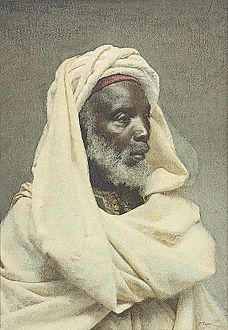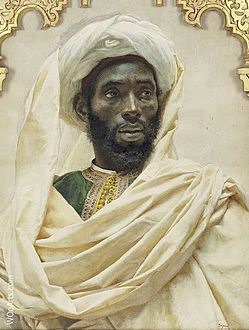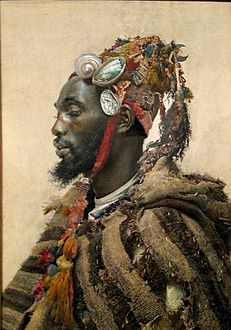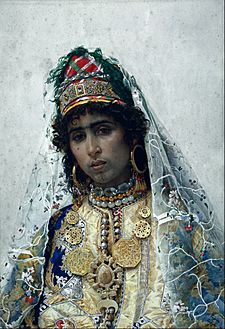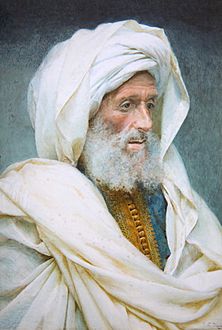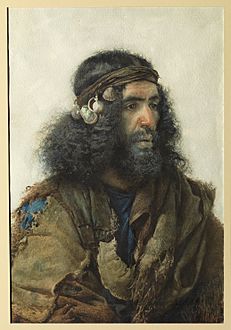Josep Tapiró Baró facts for kids
Quick facts for kids
Josep Tapiró i Baró
|
|
|---|---|

Photograph from 1864, taken in Rome
|
|
| Born | 7 February 1836 |
| Died | 4 October 1913 (aged 77) |
| Nationality | Spanish |
| Known for | Painting, Watercolor |
| Movement | Orientalism |
Josep Tapiró i Baró (born February 17, 1836, in Reus, Spain – died October 4, 1913, in Tangier, Morocco) was a famous Spanish painter. He is most known for his amazing watercolor paintings of people from Morocco.
Early Life and Art Studies
Josep Tapiró grew up in a family that owned a hardware store. From a young age, he loved to draw. His first art lessons were in 1849 with Domènec Soberano. Domènec was a local wine seller who also enjoyed painting.
In 1853, Josep and his friend, Marià Fortuny, got to show their art. Their paintings were displayed at an event held by the Casino de Reus. Later that year, both friends joined the Escola de la Llotja art school. There, Josep studied with Claudi Lorenzale, a painter linked to the German Nazarene movement. At this time, Josep mostly painted scenes from history and religious stories.
In 1857, Josep, Fortuny, and two other students competed for a special grant. This grant would allow them to study art in Rome, Italy. Fortuny won the grant. Josep then moved to Madrid, Spain. He enrolled at the "Escuela Superior de Pintura y Grabado." His teacher there was Federico de Madrazo. Josep returned to Barcelona in 1860. He helped decorate the outside of the Palau de la Generalitat de Catalunya.
In 1862, Josep joined his friend Fortuny in Rome. He met Fortuny's artist friends who gathered at the Antico Caffè Greco. They also visited Naples and Florence together. While in Rome, Josep took evening classes to learn how to paint with watercolors. His art started to focus more on everyday life scenes, known as genre painting. These paintings became very popular and helped him become well-known.
Life in Tangier
In 1871, Josep, Fortuny, and Bernardo Ferrándiz took a trip to Tangier, Morocco. This trip changed Josep's art career forever. In 1873, he had his first art show of Orientalist paintings. These were paintings inspired by the Middle East and North Africa. The show was held at the "International Art Circle of Rome."
Fortuny's sudden death in 1874 deeply saddened Josep. This made him decide to leave Rome. Instead of returning to Spain, he remembered his trip to Tangier. In 1876, he joined a group of diplomats traveling to meet Sultan Hassan I. Once in Tangier, he moved into a new home near the medina quarter, which is the old part of the city. Later, he bought an old theater to use as his art studio.
Josep lived in Tangier for the rest of his life. However, he often traveled to art exhibitions. He went to places as far away as Saint Petersburg and New York. He also spent summers with his family back in Reus.
In 1886, he married Maria Manuela Valerega Cano. She was twenty years old and from Tangier, with Italian family roots. Soon after, a Jewish friend of Maria's passed away. They adopted her orphaned son, giving him a new home.
Around 1905, Josep's health started to decline. He had lung and heart problems, which made it hard for him to work. Traveling to show his paintings also became very difficult. Fewer visitors and tourists came to Tangier because of local conflicts. This made it even harder for him to sell his art. In 1907, he and his wife rented a house in Madrid. This was a last effort to promote his work at an exhibition.
Josep's health problems eventually led to his death. He was first buried in Tangier. But in 1921, the government of Reus wanted to honor him in his hometown. In 1947, his remains were moved to Reus. He was reburied near his friend, Fortuny. A special plaque was placed on the house where he was born. In 2013, a joint art show was held to celebrate his work. It took place at the Museu d'Art i Història de Reus and the Museu Nacional d'Art de Catalunya.
Moroccan Portraits
Josep Tapiró is most famous for his beautiful watercolor portraits of people from Morocco. These paintings capture the unique clothing, faces, and daily life of the people he met there.
-
Berber Bride
-
Tangerine Woman, from the collection of
Malcolm Forbes
See also
 In Spanish: José Tapiró y Baró para niños
In Spanish: José Tapiró y Baró para niños
- List of Orientalist artists
- Orientalism




